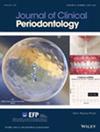机器人计算机辅助种植手术结合经瓣窦底抬高治疗单牙种植体的准确性:回顾性病例系列。
IF 6.8
1区 医学
Q1 DENTISTRY, ORAL SURGERY & MEDICINE
引用次数: 0
摘要
目的评价机器人计算机辅助种植手术(r-CAIS)在单牙种植体中经牙窦底抬高(TSFE)的准确性和安全性。材料与方法在本回顾性病例系列中,我们评估了r-CAIS联合TSFE在上颌后牙的定位准确性。术前和术后使用锥形束计算机断层扫描(CBCT)来确定种植体定位的准确性。亚组分析评估了各种因素对准确性的影响。此外,对并发症进行记录和评估。结果共纳入患者40例,种植体40枚。只有一例(病例XIX)表现为施耐德膜穿孔,穿孔率为2.5%(1/40)。冠状面和根尖的整体平均偏差分别为0.50±0.22 mm和0.54±0.21 mm,角偏差为1.25°±0.61°。线性混合模型(LMM)分析显示,亚组间(种植体位置、弓侧、骨质量、种植体类型、种植体大小和配准方法)和种植体偏差无统计学差异(p < 0.05)。结论sr - cais在单牙种植体中应用TSFE具有良好的准确性和安全性。这项研究表明r-CAIS可以获得良好的临床结果,尽管需要进一步的临床证据来证实其更广泛的疗效。本文章由计算机程序翻译,如有差异,请以英文原文为准。
Accuracy of Robotic Computer-Assisted Implant Surgery Combined With Transcrestal Sinus Floor Elevation for Single-Tooth Implants: A Retrospective Case Series.
AIM
To evaluate the accuracy and safety of robotic computer-assisted implant surgery (r-CAIS) for transcrestal sinus floor elevation (TSFE) in single-tooth implant placement.
MATERIALS AND METHODS
In this retrospective case series, we assessed the positional accuracy of r-CAIS combined with TSFE in the posterior maxilla. Preoperative and postoperative cone-beam computed tomography (CBCT) scans were used to determine implant positioning accuracy. Subgroup analyses evaluated the effects of various factors on accuracy. Additionally, complications were recorded and evaluated.
RESULTS
A total of 40 patients and 40 implants were included. Only one case (Case XIX) exhibited a Schneiderian membrane perforation, resulting in a perforation rate of 2.5% (1/40). The mean global coronal and apical deviations were 0.50 ± 0.22 mm and 0.54 ± 0.21 mm, respectively, with an angular deviation of 1.25° ± 0.61°. A linear mixed model (LMM) analysis revealed no statistically significant differences between subgroups (implant position, side of arch, bone quality, implant type, implant size and registration method) and implant deviations (p > 0.05).
CONCLUSIONS
r-CAIS showed excellent accuracy and safety for TSFE in single-tooth implant placement. This study suggests r-CAIS can achieve favourable clinical outcomes, although further clinical evidence is needed to confirm its broader efficacy.
求助全文
通过发布文献求助,成功后即可免费获取论文全文。
去求助
来源期刊

Journal of Clinical Periodontology
医学-牙科与口腔外科
CiteScore
13.30
自引率
10.40%
发文量
175
审稿时长
3-8 weeks
期刊介绍:
Journal of Clinical Periodontology was founded by the British, Dutch, French, German, Scandinavian, and Swiss Societies of Periodontology.
The aim of the Journal of Clinical Periodontology is to provide the platform for exchange of scientific and clinical progress in the field of Periodontology and allied disciplines, and to do so at the highest possible level. The Journal also aims to facilitate the application of new scientific knowledge to the daily practice of the concerned disciplines and addresses both practicing clinicians and academics. The Journal is the official publication of the European Federation of Periodontology but wishes to retain its international scope.
The Journal publishes original contributions of high scientific merit in the fields of periodontology and implant dentistry. Its scope encompasses the physiology and pathology of the periodontium, the tissue integration of dental implants, the biology and the modulation of periodontal and alveolar bone healing and regeneration, diagnosis, epidemiology, prevention and therapy of periodontal disease, the clinical aspects of tooth replacement with dental implants, and the comprehensive rehabilitation of the periodontal patient. Review articles by experts on new developments in basic and applied periodontal science and associated dental disciplines, advances in periodontal or implant techniques and procedures, and case reports which illustrate important new information are also welcome.
 求助内容:
求助内容: 应助结果提醒方式:
应助结果提醒方式:


